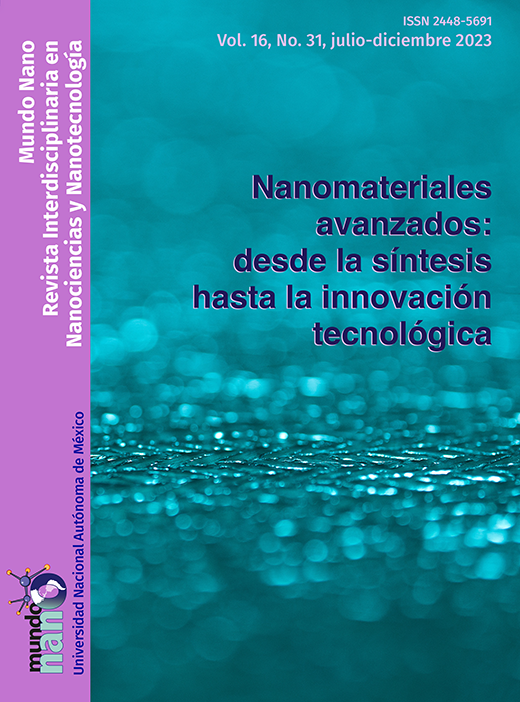Los liposomas en nanomedicina: del concepto a sus aplicaciones clínicas y tendencias actuales en investigación
Contenido principal del artículo
Resumen
Los liposomas son vesículas artificiales biocompatibles y biodegradables que poseen una estructura con dos compartimentos capaces de albergar moléculas hidrofílicas y lipofílicas, respectivamente. Los liposomas han sido ampliamente investigados durante los últimos veinte años como sistemas de liberación de fármacos, lo cual ha resultado en el desarrollo de diversas tecnologías como liposomas Stealth® y DepoFoam®. Asimismo, han surgido liposomas funcionalizados en su superficie con biomacromoléculas que pueden reconocer blancos biológicos específicos, dando lugar a potenciales terapias de alta selectividad. De igual manera, liposomas que responden a estímulos fisicoquímicos o biológicos y en los que la liberación de un fármaco estaría controlada en función de dicho estímulo. O bien, liposomas que encapsulan 2 o más fármacos, resultando así en terapias de combinación. Los liposomas son las primeras nanomedicinas en alcanzar uso clínico. Actualmente, existen al menos 20 tecnologías liposomales para tratar diversos padecimientos y alrededor de 18 están en fases clínicas de evaluación. La mayoría de liposomas comerciales se utilizan para tratar diferentes tipos de cáncer. Sin embargo, varias formulaciones liposomales para otros padecimientos han mostrado resultados prometedores. En este trabajo revisamos los conceptos básicos sobre liposomas, discutimos los casos de éxito y revisamos aquellas nanoformulaciones que se encuentran en estudios clínicos. Por último, por medio de ciencia de datos, presentamos el panorama actual de la investigación de liposomas en el área de la nanomedicina. Sin duda, los liposomas están y seguirán estando a la vanguardia en el traslado de nanotecnologías en beneficio de la salud de la población.
Descargas
Detalles del artículo

Mundo Nano. Revista Interdisciplinaria en Nanociencias y Nanotecnología, editada por la Universidad Nacional Autónoma de México, se distribuye bajo una Licencia Creative Commons Atribución-NoComercial 4.0 Internacional.
Basada en una obra en http://www.mundonano.unam.mx.
Citas
Types and phases of clinical trials. 2020;.
Angst MS, Drover DR. Farmacología de medicamentos formulados con DepoFoam™. Clin Pharmacokinet. 2006;45:1153-76. DOI: https://doi.org/10.2165/00003088-200645120-00002
Aryasomayajula B, Salzano G, Torchilin VP. Multifunctional liposomes. Methods in molecular biology. 2017;1530:41-6. DOI: https://doi.org/10.1007/978-1-4939-6646-2_3
Ashrafizadeh M, Delfi M, Zarrabi A, Bigham A, Sharifi E, Rabiee N, PaivaSantos AC, Kumar AP, Tan SC, Hushmandi K, Ren J, Zare EN, Makvandi P. Stimuli-responsive liposomal nanoformulations in cancer therapy: Pre-clinical & clinical approaches. Journal of Controlled Release: Official Journal of the Controlled Release Society. 2022;351:50-8. DOI: https://doi.org/10.1016/j.jconrel.2022.08.001
Aubel-Sadron G, Londos-Gagliardi D. Biochimie. 1984.
Barenholz Y. Doxil®-the first FDA-approved nano-drug: lessons learned. Journal of Controlled Release: Official Journal of the Controlled Release Society. 2012;160(2):117-34. DOI: https://doi.org/10.1016/j.jconrel.2012.03.020
Beltrán E, López A, Higuera I, Velázquez J, Cardona A. Nanomedicine review: clinical developments in liposomal applications. Cancer Nano. 2019;10:11-. DOI: https://doi.org/10.1186/s12645-019-0055-y
Bulbake U, Doppalapudi S, Kommineni N, Khan W. Liposomal formulations in clinical use: an updated review. Pharmaceutics. 2017;9(2):v12-v12. DOI: https://doi.org/10.3390/pharmaceutics9020012
Cai R, Chen C. The crown and the scepter: Roles of the protein corona in nanomedicine. Advanced Materials. 2019;31(45). DOI: https://doi.org/10.1002/adma.201805740
Canão F, Ferreira H, Neves NM. Liposomal formulations for lung cancer treatment in the last two decades: a systematic review. Journal of Cancer Research and Clinical Oncology. 2022;148(9):2375-86. DOI: https://doi.org/10.1007/s00432-022-04079-x
Čeh B, Winterhalter M, Frederik PM, Vallner JJ, Lasic DD. Stealth® liposomes: from theory to product. Advanced Drug Delivery Reviews. 1997;24(2-3):165-77. DOI: https://doi.org/10.1016/S0169-409X(96)00456-5
Dass CR, Choong PF. Selective gene delivery for cancer therapy using cationic liposomes: in vivo proof of applicability. Journal of Controlled Release: Official Journal of the Controlled Release Society. 2006;113(2):155-63. DOI: https://doi.org/10.1016/j.jconrel.2006.04.009
Dou Y, Hynynen K, Allen C. To heat or not to heat: challenges with clinical translation of thermosensitive liposomes. Journal of Controlled Release: Official Journal of the Controlled Release Society. 2017;249:63-7. DOI: https://doi.org/10.1016/j.jconrel.2017.01.025
Dymek M, Sikora E. Liposomes as biocompatible and smart delivery systems - The current state. Advances in Colloid and Interface Science. 2022;309:102757-. DOI: https://doi.org/10.1016/j.cis.2022.102757
El Maghraby GM, Barry BW, Williams AC. Liposomes and skin: from drug delivery to model membranes. European Journal of Pharmaceutical Sciences: Official Journal of the European Federation for Pharmaceutical Sciences. 2008;34(45):203-22. DOI: https://doi.org/10.1016/j.ejps.2008.05.002
European public assessment report summary for the public, Mepact, mifamurtide. 2013;.
Mosquirix: Opinion on medicine for use outside EU. 2015;.
An overview of Zolsketil pegylated liposomal and why it is authorised in the EU. Zolsketil pegylated liposomal (doxorubicin). 2022;.
Fantini M, Gianni L, Santelmo C. DF, Castellani C. AA, Nicolini M, Ravaioli A. Lipoplatin treatment in lung and breast cancer. Chemotherapy Research Practice. 2011;2011:125192-. DOI: https://doi.org/10.1155/2011/125192
Withdrawal of approval of new drug application for MARQIBO. 2022;.
Forssen E. The design and development of DaunoXome® for solid tumor targeting in vivo. Advanced Drug Delivery Reviews. 1997;24(2-3):133-50. DOI: https://doi.org/10.1016/S0169-409X(96)00453-X
Gabizon A, Isacson R, Libson E, Kaufman B, Uziely B, Catane R, Ben-Dor CG, Rabello E, Cass Y, Peretz T. Clinical studies of liposome-encapsulated doxorubicin. Acta oncologica. 1994;33(7):779-86. DOI: https://doi.org/10.3109/02841869409083948
Hu M, Huang L. Strategies targeting tumor immune and stromal microenvironment and their clinical relevance. Advanced Drug Delivery Reviews. 2022;183:114137-. DOI: https://doi.org/10.1016/j.addr.2022.114137
Estadísticas de defunciones registradas en el año 2021. 2022.
Kawakami LM, Yoon BK, Jackman JA, Wolfgang K, Weiss PS, Cho N-J. Understanding how sterols regulate membrane remodeling in supported lipid bilayers. Langmuir. 2017;33(51):14756-65. DOI: https://doi.org/10.1021/acs.langmuir.7b03236
Willes KL, McFarland SA, Johnson TE, Hart DR, Paxton WF. Modulating and modeling the surface ζ potential of hybrid lipid/polymer nanovesicles: implications for surface modification and drug delivery. ACS Applied Nano Materials. 2022;5(10):13820-8. DOI: https://doi.org/10.1021/acsanm.2c01407
Kontermann RE. Encyclopedia of cancer. Schwab M, editor. Berlín, Heidelberg: Springer; 2011.
Kristensen K, Urquhart AJ, Thormann E, Andresen TL. Binding of human serum albumin to PEGylated liposomes: insights into binding numbers and dynamics by fluorescence correlation spectroscopy. Nanoscale. 2016;8(47):19726-3. DOI: https://doi.org/10.1039/C6NR05455B
Kroemer G, Zitvogel L, Galluzzi L. Victories and deceptions in tumor immunology: Stimuvax®. Oncoimmunology. 2013;2(1). DOI: https://doi.org/10.4161/onci.23687
Lee Y, Thompson DH. Stimuli-responsive liposomes for drug delivery. Wiley interdisciplinary reviews. Nanomedicine and Nanobiotechnology. 2017;9(5). DOI: https://doi.org/10.1002/wnan.1450
Vascular pulmonary diseases. 2020;.
Liu P, Chen G, Zhang J. A review of liposomes as a drug delivery system: Current status of approved products, regulatory environments, and future perspectives. Molecules. 2022;27(4):1372-. DOI: https://doi.org/10.3390/molecules27041372
Mahato R. Emerging nanotechnologies for diagnostics, drug delivery, and medical devices. Chapter 2 -Multifunctional micro- and nanoparticles, micro and nano technologies. Elsevier; 2017. DOI: https://doi.org/10.1016/B978-0-323-42978-8.00002-4
Marichal L, Degrouard J, Gatin A, Raffray N, Aude J, Boulard Y, Pin S. From protein corona to colloidal self-assembly: The importance of protein size in protein-nanoparticle interactions. Langmuir. 2020;36(28):8218-30. DOI: https://doi.org/10.1021/acs.langmuir.0c01334
McDonald G. Pacira to stop making DepoCyt due to long-term production problems. 2017.
McKinney W. Data structures for statistical computing in Python. 2010;:56-61. DOI: https://doi.org/10.25080/Majora-92bf1922-00a
Mojarad-Jabali S, Farshbaf M, Walker PR, Hemmati S, Fatahi Y, Zakeri-Milani P, Sarfraz M, Valizadeh H. An update on actively targeted liposomes in advanced drug delivery to glioma. International Journal of Pharmaceutics. 2021;602:120645-. DOI: https://doi.org/10.1016/j.ijpharm.2021.120645
Nakhaei P, Margiana R, Bokov DO, Abdelbasset WK, , Kouhbanani MA, Varma RS, Marofi F, Jarahian M, Beheshtkhoo N. Liposomes: structure, biomedical applications, and stability parameters with emphasis on cholesterol. Front. Bioeng. Biotechnol. 2021;9:705886-. DOI: https://doi.org/10.3389/fbioe.2021.705886
Immunotherapy to treat cancer. 2019;.
Needham D, Anyarambhatla G, Kong G, Dewhirst MW. A new temperature-sensitive liposome for use with mild hyperthermia: characterization and testing in a human tumor xenograft model. Cancer Research. 2000;60(5):1197-201.
Noble GT, Stefanick JF, Ashley JD, Kiziltepe T, Bilgicer B. Ligandtargeted liposome design: challenges and fundamental considerations. Trends in Biotechnology. 2014;32(1):32-45. DOI: https://doi.org/10.1016/j.tibtech.2013.09.007
Nosova AS, Koloskova OO, Nikonova AA, Simonova VA, Smirnov VV, Kudlay D, Khaitov MR. Diversity of PEGylation methods of liposomes and their influence on RNA delivery. Medchemcomm. 2019;10(3):369-77. DOI: https://doi.org/10.1039/C8MD00515J
Nsairat H, Khater D, Sayed U, Odeh F, Al Bawab A, Alshaer W. Liposomes: structure, composition, types, and clinical applications. Heliyon. 2022;8(5). DOI: https://doi.org/10.1016/j.heliyon.2022.e09394
Dash P, Piras AM, Dash M. Cell membrane coated nanocarriers - An efficient biomimetic platform for targeted therapy. Journal of Controlled Release. 2020;327:546-70. DOI: https://doi.org/10.1016/j.jconrel.2020.09.012
Rincón-López J, Almanza-Arjona YC, Riascos AP, Rojas-Aguirre Y. When cyclodextrins met data science: unveiling their pharmaceutical applications through network science and text-mining. Pharmaceutic. 2021;13(8):1297-. DOI: https://doi.org/10.3390/pharmaceutics13081297
Rojas-Aguirre Y, Aguado-Castrejón K, González-Méndez I. La nanomedicina y los sistemas de liberación de fármacos: ¿la (r)evolución de la terapia contra el cáncer?. Educación Química. 2016;27(4):286-91. DOI: https://doi.org/10.1016/j.eq.2016.07.002
Sercombe L, Veerati T, Moheimani F, Wu SY, Sood AK, Hua S. Advances and challenges of liposome assisted drug delivery. Front. Pharmacol. 2015;6:286-. DOI: https://doi.org/10.3389/fphar.2015.00286
Sharma A, Sharma US. Liposomes in drug delivery: Progress and limitations. International Journal of Pharmaceutics. 1997;154(2):123-40. DOI: https://doi.org/10.1016/S0378-5173(97)00135-X
Shaw TK, Paul P. Recent approaches and success of liposome-based nano drug carriers for the treatment of brain tumor. Current Drug Delivery. 2022;19(8):815-29. DOI: https://doi.org/10.2174/1567201818666211213102308
Silverman JA, Deitcher SR. Marqibo® (vincristine sulfate liposome injection) improves the pharmacokinetics and pharmacodynamics of vincristine. Cancer Chemother Pharmacol. 2013;71(3):555-64. DOI: https://doi.org/10.1007/s00280-012-2042-4
Sivan-Peretz D, Shamrakov D, Varenik M, Koren E, Nativ-R. E, Barenholz Y, Regev O. Practical aspects in size and morphology characterization of drug-loaded nano-liposomes. International Journal of Pharmaceutics. 2018;547(1-2):648-55. DOI: https://doi.org/10.1016/j.ijpharm.2018.06.037
Taléns-Visconti R, Díez-Sales O, De Julián-Ortiz JV, Nácher A. Nanoliposomes in cancer therapy: marketed products and current clinical trials. International Journal of Molecular Sciences. 2022;23(8):4249-. DOI: https://doi.org/10.3390/ijms23084249
Torchilin-Vladimir P. How do polymers prolong circulation time of liposomes?. Journal of Liposome Research. 1996;6(1):99-116. DOI: https://doi.org/10.3109/08982109609037204
Van-Hoogevest P, Wendel A. The use of natural and synthetic phospholipids as pharmaceutical excipients. European Journal of Lipid Science and Technology. 2014;116(9):1088-107. DOI: https://doi.org/10.1002/ejlt.201400219
Wang W, Hao Y, Liu Y, Li R, Huang D, Pan Y. Nanomedicine in lung cancer: Current states of overcoming drug resistance and improving cancer immunotherapy. Wiley Interdisciplinary Reviews. Nanomedicine and Nanobiotechnology. 2020;13(1). DOI: https://doi.org/10.1002/wnan.1654
Waterhouse DN, Tardi PG, Mayer LD, Bally MB. A comparison of liposomal formulations of doxorubicin with drug administered in free form: changing toxicity profiles. Drug Safety. 2001;24(12):903-20. DOI: https://doi.org/10.2165/00002018-200124120-00004
Cancer. 2022;.
Yarosh DB. Enhancement of repair of UV damage in humans. Comprehensive Series in Photosciences. 2001;3(31):593-612. DOI: https://doi.org/10.1016/S1568-461X(01)80066-1





